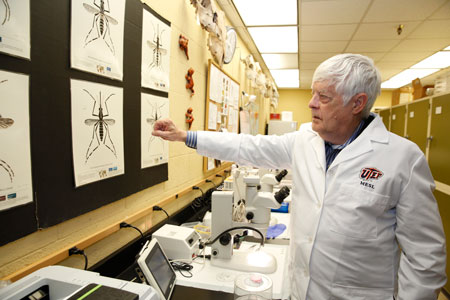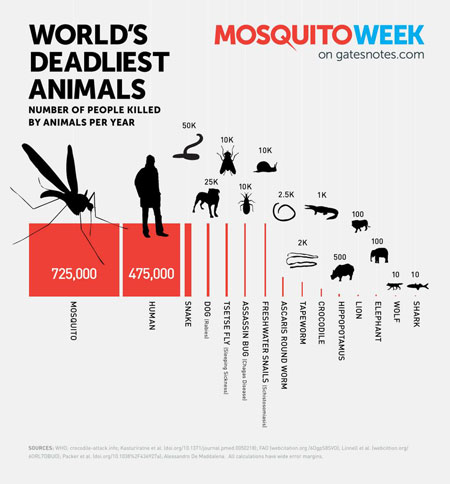Originally published June 28, 2016
By Lisa Y. Garibay
UTEP Communications
Humans are bigger, faster, smarter and more powerful than mosquitoes, yet we still can’t beat them. But for 50 years, Doug Watts, Ph.D., has been trying.
Well ahead of monsoon season – in fact, starting well before the first of the year – Watts and his team at UTEP’s Mosquito Ecology and Surveillance Laboratory (MESL) have been tracking the pesky insects’ travels around the world due to a concern that has since become a global crisis: Zika virus.

Of immediate concern is the fact that the particular mosquito that transmits Zika (as well as dengue fever and chikungunya, another disease on the rise) is the second-most abundant species in El Paso.
Watts knows this particular insect almost better than anyone. The internationally renowned researcher of mosquito-borne diseases is celebrating his fifth decade in the field and has amassed expertise in infectious disease all over the world. He began chasing down this species, Aedes aegypti, starting in 1977 in Bangkok, Thailand.
“At that time I recognized just how difficult it was to control this mosquito, to do anything to reduce the population,” he said.
Watts, who is also the co-director of infectious disease and immunology for the University’s Border Biomedical Research Center, was a research biologist for the Department of Defense (DoD) for 28 years, where he conducted field and laboratory research on the ecology and epidemiology of enteric, parasitic and viral diseases in Asia, Africa and South America. Watts also served as the scientific director of the Naval Medical Research Center’s Overseas Research Program.
After his retirement from the DoD, he worked as a scientific administrator and infectious disease investigator at The University of Texas Medical Branch at Galveston. There, his research was focused on emerging viral disease and the evaluation of candidate therapeutics and vaccines for Severe Acute Respiratory Syndrome (SARS) and West Nile viruses.
In 2013, Watts, UTEP and a team of fellow researchers from around the world were awarded a five-year, $6 million grant from the U.S. Agency for International Development (USAID) to develop and evaluate a Rift Valley fever vaccine for protecting livestock against the disease in Africa.
Watts continues to apply his vast experience to emerging viral diseases – or re-emerging, in the case of Zika, as it was first discovered in Uganda in 1947. For decades it remained obscure, non-problematic and undetected outside Africa. Yet more than 60 years later, the virus has become an international concern due to its unexpected spread and unpredictable biological effects.
Only 14 human cases of Zika virus were documented until 2007, when a Zika outbreak occurred on Yap Island, a tiny island in the North Pacific Ocean. Approximately 75 percent of the population was infected, exhibiting the symptoms that the majority of people who contract the virus will have: fever, rash, joint pain, and conjunctivitis.
“This was the alarm that Zika is on its way, it’s moving,” Watts said. “Nobody paid any attention.”
In 2013, Zika was identified in New Caledonia, 2,300 miles southeast of Yap Island. When it hit French Polynesia that same year (almost 3,000 miles away), it caused a major outbreak among an estimated 20,000 people. There, it was also first associated with Guillain-Barre syndrome, a neurological condition that can cause a kind of temporary paralysis.
And then in 2015, the virus arrived in Brazil, and the world has been on high alert since.
Watts explained that Zika virus was probably in Brazil back in 2014, but no one knew to look for it, nor what to look for.
“By that time, it spread all over Brazil and probably to other countries, just like Ebola did in West Africa,” Watts said. “That’s one of the weaknesses in our surveillance programs throughout the world. We don’t have a very effective, proactive surveillance in place. We always respond retroactively. These viruses don’t wait; they move.”
The veteran researcher is keeping in close contact with the Centers for Disease Control and Prevention (CDC) as well as health agencies around the Southwest. He hypothesizes that when – not if – Zika arrives in the U.S., it will first concentrate around the southern border of Texas, which offers an ideal mosquito environment. And despite ages of building civilization up to modern-day standards, the bugs still seem to be outsmarting humans.
Mosquito control boils down to reducing the bugs’ population density to a level that is not sufficient for transmission of a virus. To this end, the MESL has conducted studies over the past two years to gauge the local mosquito population. Watts believes it has resulted in an unprecedented amount of data valuable not just to El Paso, but also to the entire Southwest.
“I don’t think anybody in California, Arizona, New Mexico or Texas has that kind of data, and it has a lot to do with my having experience doing research and understanding what are the important questions to ask,” Watts said. “If you’re going to have virus transmission, you’ve got to have the vector for those mosquito-borne diseases. So, the first question I ask is, ‘Do we have them? And, if so, how many are out there?’”
Watts has teamed up on a grant application with New Mexico State University, North Texas University, The University of Texas Medical Branch at Galveston, The University of Texas Rio Grande Valley School of Medicine and the Ministry of Health in Matamoros, Mexico. The team aims to determine the actual impact of dengue, chikungunya and Zika on human health in the U.S.-Mexico border community of Brownsville and Matamoros.
The study will provide comparative data that will identify possible ecological, biological and socio-economic differences that contribute to the incidence of these diseases in these communities. The emphasis will be on understanding the reportedly higher incidence of mosquito-borne diseases in Mexican communities versus the U.S. border communities.
Such information is particularly critical for designing and applying vector control measures, which are the only methods available for preventing mosquito-borne diseases.
Researchers working alongside Watts include UTEP undergraduate and graduate students as well as Laboratory Director Celina Crews. They are busy day in and day out trapping mosquitoes as part of their dedicated tracking program.
Watts’ team also is racing to develop a more accurate Zika-specific diagnostic test, which will be a tremendous step toward treatment and containment of the virus. But it’s not that easy. As Watts said, “It’s a big mess.”

“The patient becomes infected with Zika virus, the virus circulates in the blood and appears about three days after the patient is infected, then it circulates through the body up to about day eight, then the virus is cleared by antibodies,” he explained. “Now, what happens when Zika infects a person who has already had an infection with a closely related virus, like West Nile or dengue or yellow fever, the antibodies produced by Zika are very much like the antibodies produced by dengue, yellow fever and West Nile. So you test the person after they have cleared [Zika] virus to try to figure out if that person had the other viruses, and it’s impossible – we don’t have a test that will distinguish among those different antibodies, they’re so closely related.”
“You’re left with a very difficult situation to try to make an interpretation,” Watts added. “A lot of people don’t get sick when they’re infected with Zika – about 80 percent don’t get any disease and 20 percent get a very mild disease … After that five-to-seven day period when you start to recover, then it’s too late [to test].”
Furthermore, there is no vaccine. Watts estimates that about 300 mosquito-transmitted diseases have been identified with perhaps 100 of them causing human disease. In the United States, there is only one approved vaccine or therapeutic for any of those diseases – yellow fever.
“If mosquito control is ever going to work, the number one priority is education,” Watts said.
To this end, MESL informs mosquito control and health care professionals working to both eliminate the pests and treat anyone who becomes infected with the diseases after being bitten. It also provides bilingual preventive education to elementary school children, leaving them with coloring books that inform well beyond just providing an artistic outlet. Some of these are tactics as simple as not allowing toys or tires to stay outside where water can pool and attract breeding bugs.
“That’s why you have to tell the kids because they’re the ones who remind you,” said undergraduate researcher Marcela Diaz. She has been working with MESL since summer 2014 as one of the dozen students (both bachelor’s and master’s candidates) on the team.
For all the work that still needs to be done, Watts can point to one aspect that has been an undeniable success.
“What’s really satisfying is to see the students having an opportunity to take part in this kind of a project,” he said. “It gives them a lot of skills that are going to give them a job in public health, or if they want to go and get an advanced degree, it gives them a background that certainly is better than most students get, a practical application through theoretical knowledge of mosquito-borne diseases.
Albert Soliz is a field and lab technician who came to MESL in 2013 as an El Paso Community College participant in UTEP’s Bridges to Baccalaureate program. After graduating from EPCC, Soliz became a full-time employee with the lab.
“My little nephew, he’s six years old, and we took him one of these coloring books,” Soliz said. “Now, if he sees water outside, he’ll come inside and say, ‘You better go get rid of that water because there’s gonna be mosquitoes here tomorrow!’ When he goes to school, he tells everybody, too – ‘Close the doors, mosquitoes are coming in!’
Zika is receiving even greater news coverage now that summer is upon us, and Watts anticipates that we’ll only see more of this in the future, for as the population of human beings increases around the world, so does the opportunity for these viruses to be transmitted.
He added, “It’s going to be a never-ending profession to stay ahead of these crazy bugs.”
Thanks to Watts and the MESL, the world will be armed with many more well-trained researchers to fight those crazy bugs and, hopefully, win.